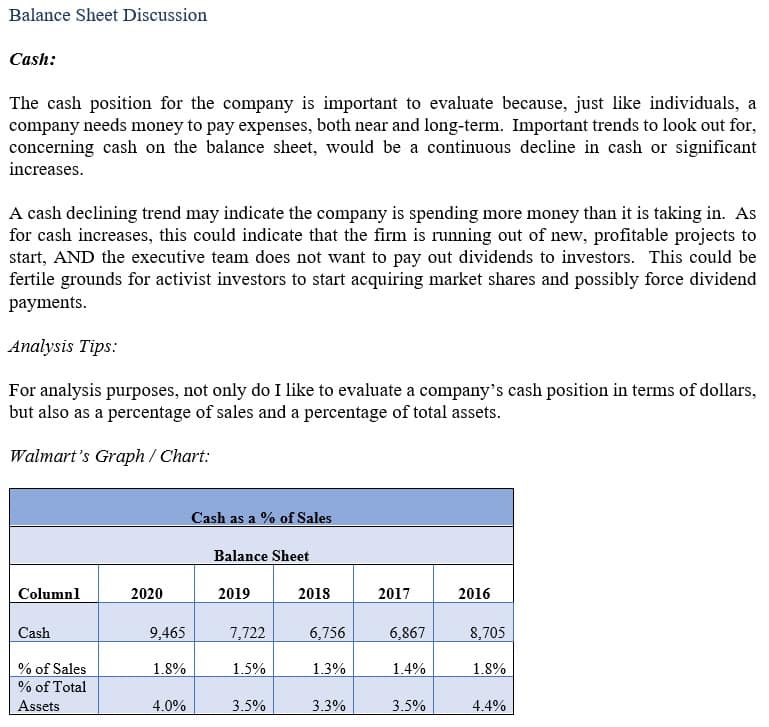🚀 Explore Walgreens' 2022 Financial Health with Expert Guidance! 📊
Walgreens 2022 Beginner’s Guide Introduction:
Hello, future financial mavens! Ready to dissect the financial well-being of Walgreens in 2022? Step into "Walgreens 2022: Beginner's Guide to Financial Analysis," provided by Quality Business Consultant and penned by the financial guru, Paul Borosky, MBA. This guide isn't just about figures; it's your comprehensive pathway to understanding the fiscal dynamics of one of the leading players in the retail pharmacy sector!
Why You'll Love This Guide:
- Navigated by a Finance Expert: 🎓 Delve into Walgreens' financials for 2022 with the insights from Paul Borosky, MBA, presented by Quality Business Consultant.
- Summary Financial Statements: 📉 Get a look at Walgreens' income statements and balance sheets for 2022, so you can gain insights into its financial strategies and outcomes.
- Extensive Financial Ratio Exploration: 🧮 Tackle over twenty vital financial ratios to assess Walgreens' fiscal performance and market position.
- Demystifying Financial Terms: 📚 Our "In other words" sections translate financial jargon into clear, actionable insights.
- Customized Analytical Techniques: 💡 Apply Paul's expert tips to enhance your ability to analyze financial data, invaluable for your academic and professional journey.
- Detailed Insights with Comprehensive Report: 🔍 For a deeper dive, our "Financial Analysis & Report" offers an exhaustive look at Walgreens, combining AI insights with Paul Borosky's expert review.
Guide Highlights:
- An approachable Legal Disclaimer
- A motivating Forward to set the stage for your financial discovery
- Thorough reviews of Income Statements and Balance Sheets for 2022
- A deep dive into Financial Ratios to boost your analytical capabilities
- A wealth of financial knowledge at your fingertips!
Table of Contents Sneak Peek:
- Dissecting Income Statements: Analyzing revenue, expenses, and net earnings
- Unpacking the Balance Sheet: Delving into assets, liabilities, and equity – the core pillars of financial health
- Mastering Financial Ratios: Providing you with the tools to analyze Walgreens' financial standing
Who's This For?
Ideal for ambitious business students and emerging entrepreneurs, this guide is your key to mastering financial analysis, focusing on Walgreens.
Enhance Your Financial Acumen:
Advance your financial literacy with "Walgreens 2022: Beginner's Guide to Financial Analysis." Transform complex financial reports into a foundation for strategic decision-making.
Additional Note: This beginner's guide is designed to establish a solid grounding in essential financial principles, centering on income statements, balance sheets, and important financial ratios for their analysis. It offers a summarized snapshot of Walgreens' 2022 financials, providing specific data, calculations, and ratios to aid your analytical endeavors. While the guide equips you with the tools for financial exploration, the detailed analysis is yours to undertake. For those seeking an in-depth, company-specific financial overview, our "Financial Analysis & Report" provides thorough insights, blending AI accuracy with Paul Borosky, MBA's seasoned expertise.
Sincerely,
Paul, MBA.
PDF/Downloadable Version

Click Below for the CURRENT
Downloadable PDF Price!!
Sample Financial Report


Brief Summary: Walgreens Boots Alliance, INC. (WBA)
The Walgreens Boots Alliance Inc., or simply Walgreens (WBA), as their headquarters in Deerfield, Illinois. The organization competes in the healthcare sector. Specifically, the pharmaceutical retail industry. At present, Walgreens employs about 230,000 individuals based on Yahoo finance provided information.
Financially speaking, the organization maintains a $35.1 billion market. Yahoo Finance reports that Walgreens has a beta of .55. This indicates that the company is less risky as compared to the overall market. However, based on their slide in stock price, I would say the company is almost negatively correlated to the market. In the last 52 weeks, Walgreens stock has fluctuated between $36.65 to $64.50. The company does pay dividends. Walgreens dividend yield the last 12 months was 4.64%. The next dividend payout date is in August.
Walgreens Financial Report Sources
“Walgreens 2019 Company Analysis… For Beginners: Financial Statements and Financial Ratios: Defined, Discussed, and Analyzed for 5 Years” was written by, Paul Borosky, MBA. and owner of Quality Business Plan. In this report, I used Walgreens 2018 10k, 2017 10k annual report, 2016 10k annual report, 2015 10k annual report, and 2019 10k annual report as the basis for information gathering.
Section 1: Walgreens Income Statement Analyzed
In this section, I walk through a broad definition as to what an income statement is and why it is important. From this, I then discuss and define income statement line items, such as revenues, gross profits, etc. in detail. After each line item is defined and discussed, I finally offer a summary analysis of Walgreens important income statement line item trends from 2015 to 2019, in most cases.
Walgreens Inc. Revenue Growth.
Walgreens had revenues of approximately $103 billion in 2015. The next two years, the company would moderately increase the revenues in the 2017 with about $118 billion. However, in the last two years, ending in 2019, the firm would substantially increase the revenues ending 2019 with revenues of approximately $136.8 billion. Surprisingly though, the organizations net profits have actually decreased as compared to the revenues. This is more than a little bit concerning from an investor’s perspective.
Walgreens 2022 Summary Income Statement |
|||||
| Column1 | 2022 | 2021 | 2020 | 2019 | 2018 |
| Revenues |
132,703 |
132,509 | 121,982 | 120,074 | 131,537 |
| COGS |
104,437 |
104,442 | 95,905 | 91,915 |
100,745 |
| Gross Profit |
28,265 |
28,067 | 26,077 | 28,159 |
30,792 |
| SG&A | 27,295 | 24,586 | 25,436 | 23,557 | 24,694 |
| Depreciation |
1,990 |
1,973 | 1,927 | 2,038 |
1,770 |
| R & D | |||||
| Other | |||||
| Total Operating Expenses |
26,878 |
25,725 | 25,095 | 23,393 |
24,503 |
| EBIT |
1,387 |
2,342 | 982 | 4,766 |
6,289 |
| Other Income | |||||
| Interest Expense |
400 |
905 | 613 | 650 |
616 |
| EBT |
3,985 |
1,995 | 446 | 4,359 |
5,975 |
| Taxes |
(30) |
667 | 339 | 577 |
998 |
| Net Income | 4,337 | 2,542 | 424 | 3,962 |
5,031 |
Section 2: Walgreens Balance Sheet Analyzed
For Walgreens balance sheet, I again go through each important line item from the balance sheet. In reviewing each line item, I will define their balance sheet line item, such as cash, property, plant and equipment, and liabilities between 2015 to 2019. Next, I then offer a summary analysis of their important balance sheet line items.
Walgreens Inc. Cash.
Walgreens Inc. ended 2019 with approximately $3 billion with cash on hand. In the next year, Walgreens would substantially increase their cash position and in 2016 with about $9.8 billion in the bank. However, the organization would then continually drop in their cash position ending 2019 with $1 billion in the bank. The substantial reduction in cash may be due to an acquisition. Also, the company may have taken out significant debt in 2016, which drove up their cash position.
Walgreens 2022 Summary Balance Sheet |
|||||
| Column1 | 2022 | 2021 | 2020 | 2019 | 2018 |
| Cash | 1,358 | 559 | 469 | 1,023 | 785 |
| Short Term Investment | 1,114 | 634 | |||
| Account Receivable | 5,017 | 5,663 | 4,110 | 7,226 | 6,573 |
| Inventory | 8,353 | 8,159 | 7,917 | 9,333 | 9,565 |
| Other | |||||
| Current Assets | 16,902 | 15,814 | 18,073 | 18,700 | 17,846 |
| Net PPE | 11,729 | 12,247 | 12,796 | 13,478 | 13,911 |
| Goodwill | 22,280 | 12,421 | 12,013 | 16,560 | 16,914 |
| Other | |||||
| Total Assets | 90,124 | 81,285 | 87,174 | 67,598 | 68,124 |
| Accounts Payable | 11,255 | 11,136 | 10,145 | 14,341 | 13,566 |
| Accrued Expense | 7,899 | 7,260 | 5,861 | 5,474 | 5,862 |
| Accrued Taxes | 84 | 94 | 95 | 216 | 273 |
| Notes Payable | 1,059 | 1,305 | 325 | 5,738 | 1,966 |
| LT Debt - Current | |||||
| Other | |||||
| Total Current Liabilities | 22,583 | 22,054 | 27,070 | 25,769 | 21,667 |
| LT Debt | 10,615 | 7,675 | 12,203 | 11,098 | 12,431 |
| Other | |||||
| Total Liabilities | 59,717 | 57,145 | 66,038 | 43,446 | 41,435 |
| Common Stock | 10,950 | 11,000 | 10,773 | 10,651 | 10,505 |
| Treasury | 20,683 | 20,593 | 20,575 | 19,057 | 15,047 |
| Retained Earnings | 37,801 | 35,121 | 34,210 | 35,815 | 33,551 |
| Other | |||||
| Total Equity | 29,366 | 23,822 | 21,136 | 24,152 | 26,689 |
| Total Equity & Liability | 90,124 | 81,285 | 87,174 | 67,598 | 68,124 |
Section 3: Walgreens Financial Ratios Analyzed
For this section, I have chosen several different financial ratios to review for Walgreens from 2015 to 2019. In reviewing each of their financial ratios, I first start with defining the financial ratio. Next, I supply the financial formula for calculating the specific ratio. Finally, I offer a brief analysis of their important Financial ratios.
Walgreens Inc. Current Ratio.
In 2015, Walgreens had a current ratio of approximately 1.19. Because the company does deal with retail, the organization should employ a lower current ratio as compared to other industries. For example, Walmart continuously has a current ratio well below 1.0. This is because these types of organizations continually generate cash on a daily basis. This enables the firm to optimize its current assets at a higher rate as compared to other industries. In my most humble of opinion, Walgreens needs to employ similar strategies as compared to other retail industry competitors.
Walgreens Inc. Total Asset Turnover.
Walgreen's total asset turnover ended 2015 at 1.50. In the next four years, Walgreens will continually improve their total asset turnover ending 2019 with 2.02. This indicates that Walgreens management teams are taking steps to continually increase their total asset utilization. Also, the firm may be liquidating underperforming assets to help improve this ratio on a continuous basis.
Walgreens Inc. Return on Assets.
Walgreen's return on assets ended 2015 at 6.22%. In the next four years, Walgreens would fluctuate between 7.39% in 2018 to 5.77% in 2016. The significant fluctuation of return on assets shows that the organization does not have a coherent strategy to continually improve and optimize the usage of assets from the perspective of revenue generation. To improve on this ratio, the organization may wish to close down underperforming stores or take action to improve inventory holding practices.
Walgreens Inc. Debt ratio.
Walgreens ended 2015 with the debt ratio of 19.36%. In the next year, the organization’s debt would climb to 25.73%. Fortunately though, the last three years, Walgreens has taken significant steps to reduce their current debt ratio. The steps resulted in a debt ratio of 16.42% in 2019. In my opinion, this debt ratio may be an optimal level for the organization. Going any lower may jeopardize the company’s ability to exploit right off opportunities for interest payments. Also, additional funds that may be paid to paying down the debt could be used for expansion purposes.